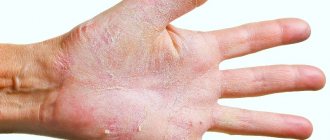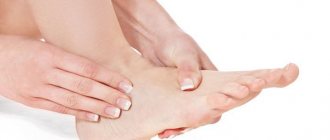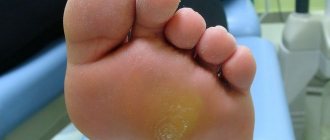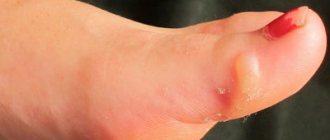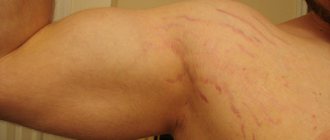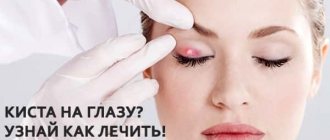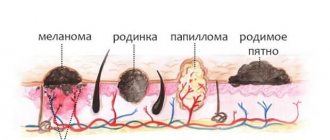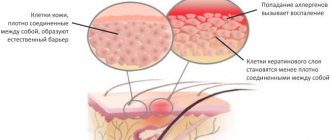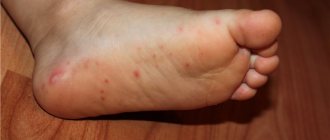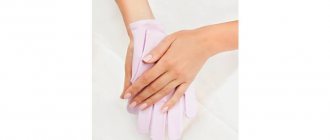For many girls and guys, calluses on the feet are a familiar and very painful topic. They can seriously limit movement, causing not only discomfort when walking, but also serious pain. Core calluses are considered one of the most painful and difficult to remove. They occur in people of any age, have a characteristic appearance and are accompanied by painful sensations. A distinctive feature is the sudden appearance after a certain period of time, even after complete disappearance. Let's take a closer look at the reasons for the appearance of corns with a core, what they look like, where they are most often localized and what ways you can get rid of them.
What it is
Having discovered a hardened area of skin on his foot, heel or between his toes, a person wonders: what could it be?
The roughening of the skin is aimed at mechanically protecting a certain area from external damage.
Inside such a callus there is a dense core, which makes home treatment of the problem more difficult. The article will discuss how to get rid of calluses using medications and folk remedies.
The concept of a core callus
A callus on a toe or foot is also called an ingrown callus. It consists of a root or rod that goes deep into the dermis; the area of skin on top is very rough.
The more you delay treatment, the more the callus will grow and cause negative sensations to the patient. The initial stages of the disease can be easily treated at home; advanced forms require surgical intervention.
Patients are interested in how the subcutaneous core is formed in the groin or other area of the skin? The mechanism for the development of such a formation is as follows: under constant mechanical influence on a certain area of the leg, the skin rubs against clothing or shoes.
Dead cells of the epidermis do not have time to separate, new ones formed are located under them. As a result, this area of skin becomes rough and takes on a keratinized appearance.
As a result of prolonged mechanical pressure on the skin, keratinized cells go into the deep layers of the dermis, thereby forming a dense core.
A callus on the sole of the foot compresses small blood vessels, disrupts cell nutrition, and causes severe discomfort to the patient in everyday life. A photo of such a formation can be seen below.
Diagnostics
An experienced dermatologist determines the type of pathology through a visual examination. A callus with an internal hard core must be distinguished from a plantar wart. The latter occurs with heavy loads on the same areas of the foot. The wart is hard and painful when pressed, covered with a layer of keratinized cells, so its structure is difficult to see. This neoplasm has roots growing into the epidermis. In contrast, the core callus:
- does not bleed even at maximum pressure;
- appears as a separate growth (warts form in groups);
- it has a small depression in the center, and the wart is riddled with thin fibers. When the wart is steamed and the top layer is removed, small pinkish papillae and black dots are visible.
Diagnosis of internal callus involves laboratory blood testing. It is used to determine:
- sugar level;
- glycated hemoglobin content (in the absence of diabetes mellitus);
- titers of antibodies to papillomatosis virus, human immunodeficiency.
Provoking factors
A hard core under the skin appears as a result of prolonged wearing of uncomfortable shoes. As a result of this process, the patient’s legs suffer from excessive mechanical pressure, which causes the appearance of such a formation.
Very often, this type of formation is found in professional athletes (dancers, ballerinas, etc.) and women who abuse high-heeled shoes.
Other reasons for the appearance of callus include:
- a splinter that was not removed in a timely manner;
- delaying the treatment of ordinary calluses, which over time develop into complicated forms;
- the elderly age of the patient (it is in older people that the skin becomes rough, which in itself increases the chances of the formation of a callus);
- infectious lesions of wounds or cracks on the toes (the presence of damage between the toes increases the chances of pathogenic microflora entering, the active activity of which leads to the formation of an internal core).
The attending physician will help determine the exact cause of the problem after a careful examination of the patient.
Causes of corns from the root
Core calluses most often occur due to prolonged compression of soft tissues. Reasons for the formation of corns with roots:
- narrow hard shoes, high heels;
- after removing a foreign body (splinter, glass, sliver, sand);
- neglected old dry callus;
- increased physical activity when playing sports;
- inflammatory joint diseases;
- tendency of the skin to become keratinized;
- calluses appear on the finger due to playing stringed instruments;
- associated diseases: flat feet, osteochondrosis, spinal curvature, diabetes mellitus, psoriasis, dermatitis;
- poor foot hygiene;
- increased sweating;
- congenital features of the feet.
Main symptoms
It is very easy to recognize a core callus. Such formations have the following characteristics:
- in appearance it resembles a small crust with a characteristic center in the middle;
- when pressed, unpleasant pain occurs;
- it becomes difficult for the patient to walk.
It is worth noting that this problem often occurs among people whose profession involves a high workload (builders, loaders, etc.). The appearance of calluses is associated with failure to follow banal safety rules (use of gloves, comfortable shoes, etc.).
Features of the use of celandine
Celandine is a perennial plant. Its stems and leaves contain yellow-orange juice, rich in:
- tannins;
- carotene;
- organic acids;
- essential oil;
- saponins.
The composition contains alkaloids, which in large quantities have a toxic effect on the body. You should strictly adhere to the recipe to avoid poisoning.
Celandine juice contains a high percentage of citric, malic, and ascorbic acids. These substances provide a keratolytic effect, soften keratinized skin, but can damage healthy epidermal cells. To prevent burns, it is important to apply medications prepared from celandine locally. The skin around the callus should be lubricated with Vaseline or zinc paste .
Treatment methods
Treatment methods depend on the form and stage of formation of the formation core. The initial stages can be easily treated at home; more complex cases require surgical intervention.
How to remove a callus yourself
If the callus is not deep and is detected at an early stage of its appearance, then treatment at home will help get rid of it. Therapeutic measures include the use of external agents in the form of ointments or gels, which help soften the skin and prevent the proliferation of fungal and bacterial flora.
Special callus plasters Salipod and Enitsa are common. They are glued directly to the affected area, left for 7 days, then the patch is carefully removed along with the callus core.
In the future, you need to treat the area with antibacterial ointments to prevent injections from getting into the wound.
ethnoscience
Many patients prefer non-traditional methods of removing tumors and are interested in how to cure the problem in a short time?
Common and effective methods include:
- fresh onion compress. The patient needs to thoroughly wash the area with the callus, steam the skin and carefully remove the upper portion of the skin. Apply a little acetic acid to the affected area and cover with a piece of fresh onion, leaving the compress overnight. In the morning, the affected area is thoroughly washed, separated skin fragments are removed and sprinkled with crushed streptocide. Similar manipulations are carried out until the callus completely disappears;
- compresses from fresh potatoes and onions. Vegetables are grated on a fine grater, the resulting mass is distributed over the entire affected area, covered with gauze and left overnight. In the morning, the separated areas are removed and the procedure is repeated until complete recovery.
Traditional treatment is advisable to carry out in the initial stages of development of the formation; with deep lesions, such methods are ineffective.
Hardware treatment
Removal of deep rods is carried out through surgery. Today this is done using a laser or liquid nitrogen. Excision of a callus with a laser is the most minimally traumatic and effective method, allowing you to completely remove the deep core.
Among the advantages of this technique are:
- absence of blood loss and possible wound infection;
- complete removal of the root (no repeated relapses);
- easy postoperative period;
- absence of scars or cicatrices (very important when removing calluses in “visible” places).
Reviews from patients who have undergone the removal of rods show that the use of a laser is much more effective than cryodestruction. This procedure allows you to remove the rod from any part of the body (on the little finger, foot, hand, between the fingers, etc.).
Contraindications to laser removal include pregnancy and breastfeeding, autoimmune disorders, diabetes mellitus and bleeding disorders.
How to cure corns on feet with a stem using folk remedies
Time-tested remedies are inferior in effectiveness to medications, but this does not mean that they do not work. You will just need more time to remove it, since only very tiny formations will succumb in one session. Among the folk remedies that will help you:
Aloe
- Cut a leaf from an old plant and put it in the refrigerator for 2-3 days. Take a small piece, cut off the thorns and cut it lengthwise into two halves.
- Apply the cut side to the foot and secure with a plaster or bandage. Put a sock on top.
- Change the sheet twice a day, without removing it either day or night, until the skin is completely cleansed.
- During hygiene procedures, mechanically remove the upper layers of the epidermis.
Lemon juice
photo from the site https://fitohome.ru
- Finely chop, or better yet, grate half an onion. Apply the resulting mass to the formation.
- Wrap your leg in cling film, which you remove while bathing.
- Renew the onion mixture daily and continue until you get the desired result.
- A mask made from raw grated potatoes is used in a similar way.
Flax seed decoction
- Place 3 tbsp in a saucepan. flax seeds and 150 g of peelings left after cooking potatoes.
- Add 0.5 liters of water, bring to a boil and simmer covered for 25 minutes.
- Soak a piece of cotton wool, cut to the size of the corn, in the hot broth.
- Apply the sponge to the formation for 8 hours, then remove the pliable layers of the epidermis.
- Repeat daily until you get rid of the problem completely.
Depending on the size of the formation, removal using folk remedies can take from a week to 2 months. But with due diligence, everything will definitely work out.
Prevention
For prevention, doctors give the following recommendations:
- wear loose and comfortable shoes;
- if there are cracks or wounds, treat them with antiseptics to prevent infection;
- observe all rules of personal hygiene;
- clean rough areas of skin with pumice stone and thoroughly lubricate with rich cream.
When the first unpleasant signs appear, you should not delay treatment. Severe forms of formations require long-term and professional therapy.
Conclusion
A callus is formed by constant friction of the skin against a certain surface (clothing, shoes, etc.).
Untimely treatment leads to the fact that the root of the formation grows into the deep layers of the dermis and causes severe discomfort to the person. Therapy in the early stages allows you to remove the callus at home.
Possible complications
Most often, the complication that causes a callus appears after an infection. In such cases and suppuration may begin sepsis . This condition requires the use of broad-spectrum antibiotics and constant medical supervision.
Signs of infection
When an infection enters the callus cavity, the patient develops the following symptoms:
- Redness of the skin surface. It can be located either around the callus or spread throughout the leg.
- A feeling of pulsation at the site of the lesion, an increase in temperature.
- Severe pain and swelling.
- Accumulation of purulent contents in the callus cavity. It is dangerous to squeeze out or remove the contents yourself!
- The spread of infection throughout the body is accompanied by an increase in nearby lymph nodes.
If a bloody callus appears, do not panic - timely measures taken can minimize the likelihood of complications. Self-medication is not recommended to avoid worsening the condition.
Recipes
The use of celandine for calluses and corns is varied. To soften rough skin, you can use the juice of the plant, prepare a medicinal ointment, or make an infusion for a bath or compress.
Removing growth with juice
An easy way to remove calluses is with fresh juice. You should break off the stem and apply orange liquid to the keratinization. When it dries, repeat the treatment. Treatment should be carried out 3-5 times a day until the skin clears. In winter, prepared elixir is used.
It should be remembered that the plant contains a pigment that leaves permanent stains on clothes and turns the epidermis brown. During the treatment process, it is important to be careful and wear cotton socks after treatment.
Infusions and decoctions
Decoctions and infusions for corns are useful for foot baths:
- To make a decoction, you need to pour boiling water over the plant in an enamel bowl at the rate of 1 tablespoon of dried raw material per 200 ml. Place in a water bath and heat over low heat for 15 minutes. Then turn off and cover the broth with a towel. After an hour, strain.
- The infusion is made differently. Two spoons of dry raw materials are placed in a half-liter thermos in the evening and filled with boiling water. In the morning, filter and cool.
The decoction or infusion is diluted with hot water in a ratio of 1: 3 in a wide basin. Place the foot in the bath and hold for 20-30 minutes. Then wipe and clean the softened calluses with pumice. The procedure has an antiseptic effect, soothes pain and irritation.
Ointment
Ointment helps remove calluses. For its oily base you will need Vaseline, lanolin or baby cream:
- Grind the dry stems of celandine thoroughly in a mortar or coffee grinder to a powder.
- Mix with the base in a ratio of 1:4. Transfer to a glass jar with a lid. Store in a cool, dark place.
- Instead of dried raw materials, you can take fresh juice or decoction, maintaining the proportions.
- The ointment does not lose its healing properties for 2 weeks.
The medicine should be applied in a thick layer to the keratinized sole of the foot 3-5 times a day. The course of treatment is about a month.
Compresses
Compresses are recommended for old calluses and corns.
For cooking, it is better to use fresh celandine leaves. They need to be finely chopped and lightly mashed so that the juice comes out. Wrap the mixture in gauze and apply to your leg. Secure with polyethylene and bandage. It is recommended to apply the compress in the evening, after a therapeutic bath, and leave it until the morning. The next day, clean the softened skin with a scraper. Repeat the procedure for 1-2 weeks.
In winter, a compress can be made from dried grass. Pour a spoonful of raw material with a small amount of boiling water to soak it into a paste. After 15 minutes, squeeze, wrap the cake in gauze and place on the keratinized area.
Recommendations for caring for a bloody callus
- First of all, they get rid of pressure on the injured area;
- protect the callus from friction using a bactericidal patch;
- try to keep the bubble in the open air more often;
- a wound healing or antiseptic agent is applied at night;
- bloody and wet neoplasms that cause significant pain are pierced, while maintaining sterility.
After a blister ruptures, the area should be treated and kept sterile.
Harvesting the plant
Proper procurement of raw materials is of great importance. Celandine should be collected during the flowering period, starting at the end of May and lasting throughout June, adhering to several rules:
- You need to go to work in the morning, choosing a sunny day. It is better to protect your hands with latex gloves to prevent juice from coming into contact with your skin.
- To get an environmentally friendly medicine, you need to choose grass that grows far from highways, plants and factories.
- It is recommended to cut the stems with a sharp knife at a level of 10-15 centimeters from the soil. If it is necessary to prepare the root, the plant is carefully dug up and washed in running water before drying.
- For further actions, you need to choose a room with good ventilation. This could be a regular attic. Newspapers are laid out on the floor and cut stems are placed in a thin layer. They need to be turned daily to prevent the product from rotting.
Many housewives dry celandine by tying it into small bunches and hanging it on the wall. This is a good way to obtain high-quality raw materials for medicine in the shortest possible time.
Dried stems are stored in a dry place, wrapped in gauze. You can chop the grass, put it in a fabric bag and hang it in a ventilated area away from sunlight. The shelf life of the dry mass is 3 years.
Preparing juice
Celandine juice quickly helps with calluses. You can prepare it for future use:
- Fresh stems and roots are thoroughly washed and moisture is shaken off the leaves.
- Scroll everything together through a meat grinder. Squeeze the juice through cheesecloth into a glass jar and seal it tightly.
- Place the container in a dark place. After a week, the product begins to ferment. The lid must be opened regularly to release accumulated gas.
- After a month, fermentation ends. The juice should be strained and stored in the refrigerator. Use within six months.
You can prepare an alcoholic elixir. To do this, the squeezed juice is mixed with alcohol in a ratio of 2:1. Cover with a lid and place in the cellar for 3 weeks. Then it is filtered and used for treatment throughout the year.

